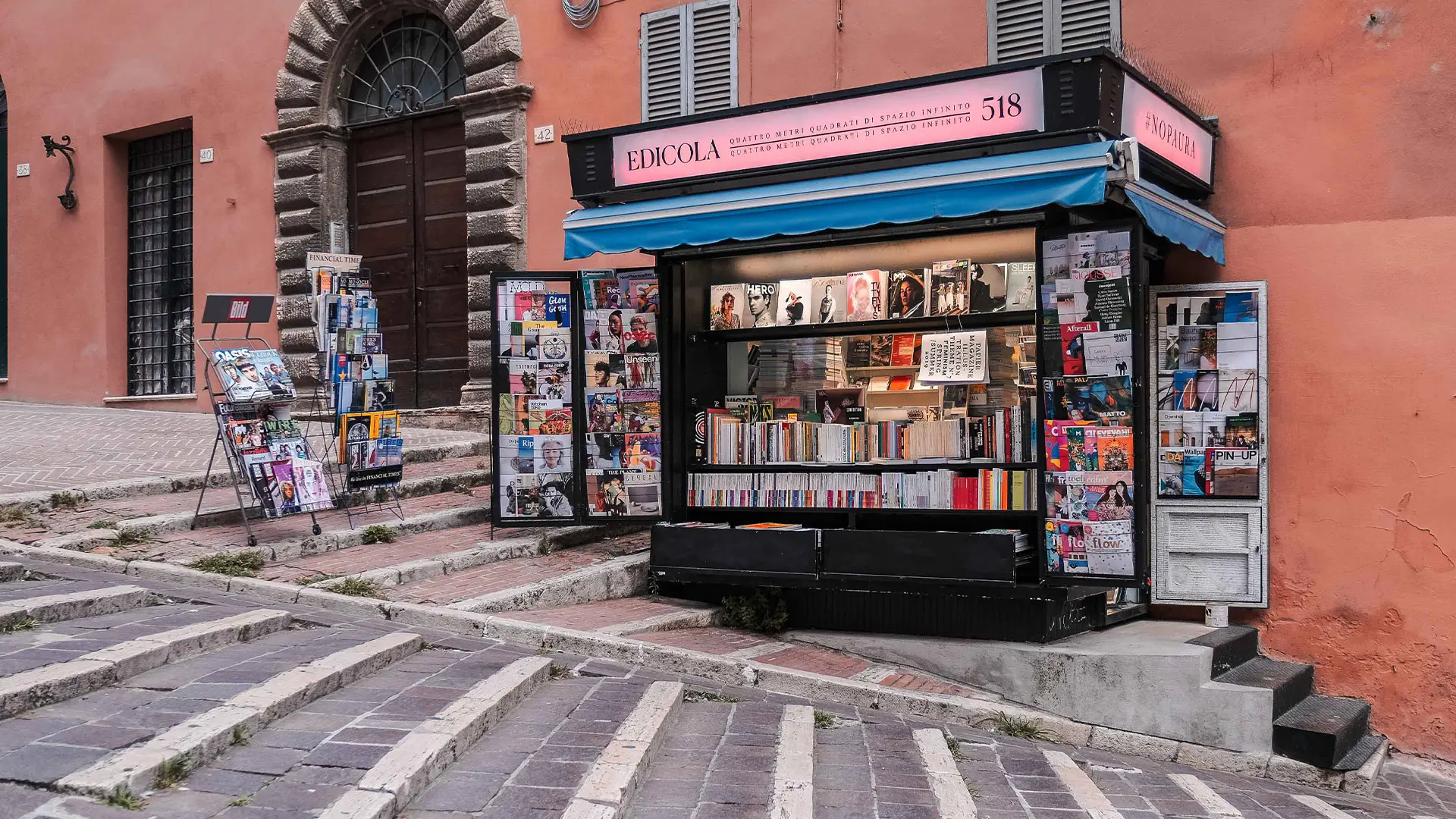For the third consecutive year, the Federation is taking part in the international fair on the circular economy. Helping to strengthen processes of value creation that are not just sustainable but also inclusive
Passionate, multi-channel, sustainable: design as narrated by the magazines

Edicola 518, Perugia, ph. Alberto Brizioli
We asked Elledecor.it, 90+10 and Espaces Contemporains how they are preparing for the Salone del Mobile.Milano 2022 and what to keep an eye out for design-wise
Starts this week the date with the world of design as seen through the lens of the publications that keep track of the changing modes of home living and designing, providing their readers with an extensive and multifaceted overview. This week: Elledecor.it, 90+10 (Argentina) and Espaces Contemporains (Switzerland).
Roland Durussel, editor of the Swiss magazine Espaces Contemporains, reveals the secret weapon in the armoury of every successful magazine: passion. “Being a newspaper editor has become a real challenge,” he said, given that a good many things have changed since the magazine first came out in 2004. Espaces Contemporains is celebrating its 100th edition this very month, a milestone in a journey of perseverance and enthusiasm: “An opportunity to look in the rear-view mirror and consider everything we’ve created and achieved, and assess it through the lens of time and experience. It’s also an opportunity for introspection and analysis – and, most of all, it’s the time to focus firmly on the future.”
A future that the editors of Elledecor.it, are gearing up for, considering how best to meet the challenge of narrating design these days, how it comes into our homes, what direction production is taking, what the designers have in mind and what impetus drives the objects that then become part of our lives. The editor in chief, Alessandro Valenti, underscores the fact that Elledecor.it is preparing for the June Salone with a dedicated, highly detailed programme of content – critiques, reviews and selections and a thorough look at the world of social media: “With the Salone almost upon us, it’s time to start talking again on one hand about the product previews, broadcast and promoted by digital platforms such as our own, and on the other about what we can expect to see in person at the fair. The collection previews and the live experience are particularly keenly anticipated this year. The impression is that, finally, online and offline have become complementary and have started weaving promising relations, which is why elledecor.it has decided to cover the 2022 edition of the event, including the world that gravitates around it. In the run-up to the fair, the focus will be on projects already presented by the companies: multichannel articles, launched on the website’s Design Show section, will fill us in on all the latest (and innovative) things, we will interview the people who think them up (and those who produce them) and discuss their many features.
There will be a step change from 7th to 12th June, with the advent of a new smart, digital and multi-platform guide devised in the manner of a daily diary to help visitors find their feet and decide what to see. A new generation newsletter will also be introduced: the format will be known as Elle Decor Daily News and will notch up 1.3 million Facebook fans, 890 Instagram followers and, thanks to a partnership with Syncronia, a database di 330,000 signed-up architects and designers who will have an opportunity to book visits and events.
There will also be live reportage: physically going in and out of the pavilions, harnessing multimedia tools, discussion on home living, lifestyles, different modes of habitation, in an attempt to get a handle on the potential of the objects and how they relate to our bodies. The experience will take centre stage. Moreover, as Emanuele Coccia writes: ‘We really only inhabit things. It is the objects that host our bodies, our gestures, grab our attention, prevent us from clashing with boxy areas, the perfect geometry of our homes, protecting us from its violence. The box house is, from a technical point of view, a sort of desert, a purely mineral structure.’”
Marcela Fibbiani, editor of the Argentinian magazine 90+10 provides a broader view of where design is headed, championing more responsible consumption: crucial and underpinned by the great changes that the editorial staff of 90+10 monitors in the world of design and the world of modern thinking: “The visionary words of the designer and theorist Víctor Joseph Papanek (Vienna, 1923 - Kansas, 1998) – who devoted his life to the study of the social responsibility of design and its impact – warned us way back in 1971 of the urgent need to design for the real world, saying that design should be an innovative, highly creative and interdisciplinary tool that responds to people’s real needs and be research-based, putting an end to ‘dishonouring the Earth itself’ with objects and fabrications that have no reason to exist. With his positive vision, Papanek assures us that design is the protagonist of social change: ‘design has become the most powerful instrument harnessed by man for configuring its tools and its environment (and, therefore, society and him/herself). This means that designers have a huge moral and social responsibility. The fact that his 1995 book The Green Imperative has recently been republished comes as no surprise. Sustainability is the keyword uppermost in the design agendas (and others), especially in the wake of the pandemic, which wrought a sea change for mankind. The duty to stop and spend more time at home enabled us to rethink our lifestyles and reconsider the way we produce and consume, both individually and collectively. We are agreed that building a more sustainable and ecological future is the only possible way forward, and, as Papanek urged, design has a great deal to offer in this sense. For instance, when consumers are mulling over the question of seating, they have to consider how far they are willing to compromise as regards the sustainability of the chair they are thinking about buying. One could say that this is the driving trend of today (pretty much consolidated), and this is something the manufacturing companies are well aware of – which is why they have spent years reinventing themselves in this regard and are keener than ever today to make their consumers aware of the changes they have brought into play. The Salone del Mobile.Milano exhibitors are proud to fling open the doors of their premises and to discuss their operating strategies, championing the use of local, recycled and upcyclable materials devoid of toxic substances; they factor in the impact of transport and use technology as an ally of innovation, seeking a more efficient production model. All these factors, as well as the adequacy of the working conditions offered by companies, are taken into consideration by the consumer who, obviously, also demands high quality, durable, functional, comfortable and good-looking products. Let us not forget that good looks play a fundamental part in our choices. Finally, if the chair we settle on satisfies all the ‘requirements’ set out above, it will remain a part of our lives for a good long time and may well be inherited by someone else. Because surrounding ourselves with responsibly designed and produced objects that are useful and pleasing improves our daily lives and also makes us happier.”
Above, picture of the Edicola 518 in Perugia, "not a simple newsstand: the temple of beautiful paper. A space of freedom and revolution in the heart of Perugia."
Check out the previews










